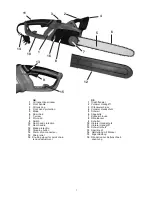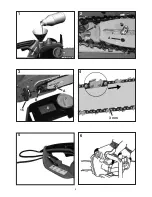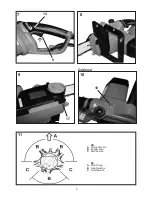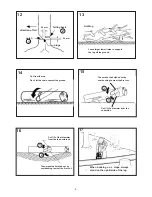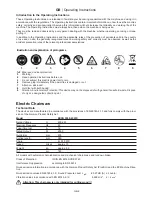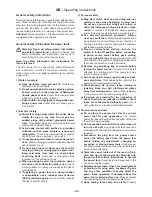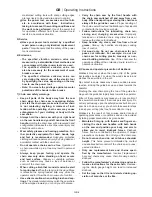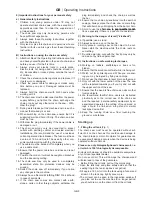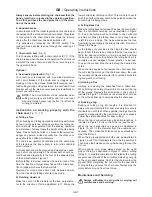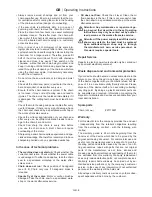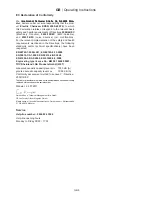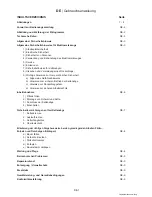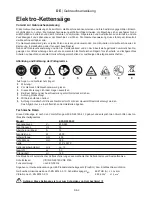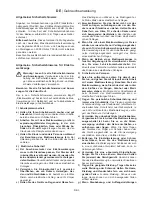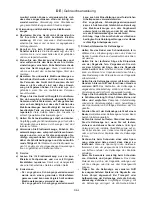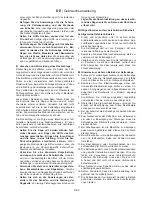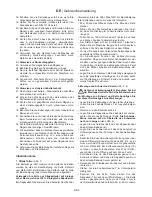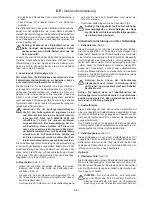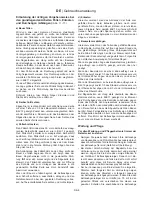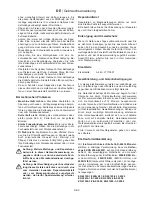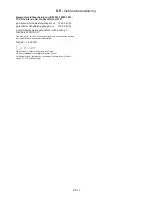
GB
|
Operating Instructions
GB-8
• Always remove wood shavings and oil from your
chain saw after use. Ensure in particular that the mo-
tor ventilation slits for cooling the motor in the housing
of the chain saw is free (danger of overheating).
• If the saw chain is particularly dirty, e.g. in case of
gumming with resin, remove the chain and clean it.
Place the chain for a few hours in a vessel containing
chainsaw cleaner. There-after clean the chain with
clear water. If the chain is not used again immediately,
it must be treated with service spray or a customary
anticorrosion-spray.
• Only in case of use of biological oil: As some bio-
logical oils may tend to encrust after a time, the oiling
system should be rinsed thoroughly before storing the
chain saw for a longer period. Therefore, please fill
half of the oil reservoir (about 70 ml) with chainsaw
cleaner and close it as usual. Then switch on the
chainsaw - without bar and chain being mounted - and
keep it running until the total rinsing liquid has evapo-
rated through the oil opening of the chain saw. Before
using the chain saw again, it is absolutely necessary
to refill the oil reservoir.
• Do not store the saw outdoors or in damp and moist
areas.
• Check all the chain saw parts, in particular the chain,
bar and sprocket, of wear after every use.
• Ensure that the chain tension is correct. If the chain
is too loose, it may come off during use and lead to
injuries. The chain must be replaced immediately if it
is damaged. The cutting teeth must be at least 4 mm
long.
• Check the motor housing and power cable after every
use for damage. If there is any sign of damage, have
the chain saw checked by a specialised workshop or
the works after-sales service.
• Check the oil level and lubrication of your chain saw
after every use. Insufficient lubrication leads to dam-
age to the chain, bar and motor.
• Check how sharp the chain is every time before
you use the chain saw. A blunt chain will cause
overheating of the motor.
• Sharpening a saw chain requires experience and spe-
cialised knowledge. We therefore recommend to have
sharpening carried out by a specialised workshop.
In the case of technical problems
•
The machine does not start up:
Check whether the
current socket is live. Check whether the power cable
is undamaged. If neither case applies, take the chain
saw to a specialised workshop or the works after-
sales service.
•
Chain does not run:
Check position of handguard
(see ill. 8). Chain only runs if handguard brake is
released.
•
Sparks fly at the motor:
Motor or carbon brushes
damaged. Take the chain saw to a specialised work-
shop or the works after-sales service.
•
Oil does not flow:
Check the oil level. Clean the oil
flow openings in the bar. If this is not successful, take
the chain saw to a specialised work-shop or the works
after-sales service.
Attention: Any maintenance or repair work go-
ing beyond that described in these Operating
Instructions may only be carried out by author-
ised persons or the works after-sales service.
Attention: If the power supply lead of this device
shows any defects, the lead must be replaced
by an authorized repair shop only or through
the manufacturer’s own service personnel, as
this work requires special tools.
Repair Service
Repairs to electric power tools should only be carried out
by specialist electrical personnel.
Waste disposal and environmental protection
If your device should become useless somewhere in the
future or you do not need it any longer, do not dispose
of the device together with your domestic refuse, but dis-
pose of it in an environmentally friendly manner. Please
dispose of the device itself at an according collecting/
recycling point. By doing so, plastic and metal parts can
be separated and recycled. Information concerning the
disposal of materials and devices are available from your
local administration.
Spare parts
Chain (
400 mm)
# 27110997
Warranty
For this electric tool, the company provides the end user
- independently from the retailer‘s obligations resulting
from the purchasing contract - with the following war-
ranties:
The warranty period is 24 months beginning from the
hand-over of the device which has to be proved by the
original purchasing document. For commercial use and
use for rent, the warranty period is reduced to 12 months.
Wearing parts and defects caused by the use of non fit-
ting accessories, repair with parts that are not original
parts of the manufacturer, use of force, strokes and
breaking as well as mischievous overloading of the motor
are excluded from this warranty. Warranty replacement
does only include defective parts, not complete devices.
Warranty repair shall exclusively be carried out by au-
thorized service partners or by the company‘s customer
service. In the case of any intervention of not authorized
personnel, the warranty will be held void.
All postage or delivery costs as well as any other subse-
quent expenses will be borne by the customer.


